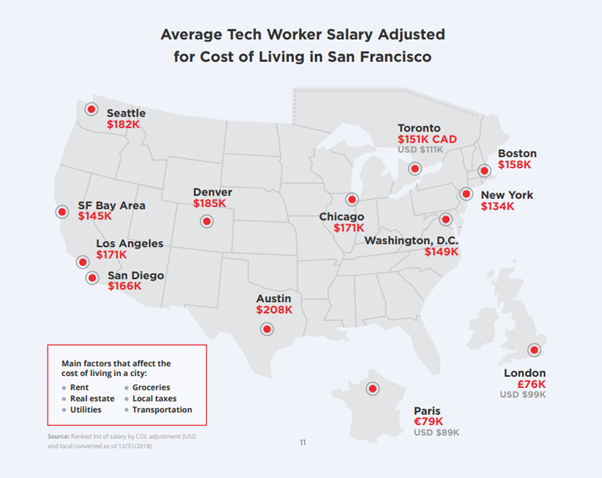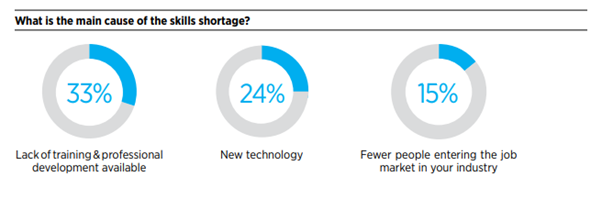Salary trends provide valuable insight about the economy and career opportunities across geographies and industries.
On the plus side, economic surveys and research reports offer data-driven insights into a variety of topics: new technologies, long-term growth, and hiring trends—useful to those in need of new talent and candidates pursuing a career. But these surveys can have some drawbacks. The findings are rarely consistent across reports. For the average reader, the results might be overwhelming or too technical.
That’s why we put together this IT salary roundup: to summarize the most important findings from four popular IT salary research reports and surveys. These results can help you make the right decisions in support of a successful future in the U.S. tech industry.
Hired’s 2019 State of Salaries Report
Hired compiles salary trends across various technologies based on the geographic locations. The report answers key questions, primarily from the perspective of employees. The data is collected widely: from online marketplaces, interview requests from more than 420,000 participants, job offers across 10,000 companies, and 98,000 job seekers across 13 cities.
Here are some of the interesting findings from the report:
- Tech-related salaries lead the nation. The highest paying sectors in the U.S. are IT, ecommerce, entertainment, and healthcare.
- Tech workers want more compensation for their skills and are willing to relocate for it. The tech hub of the San Francisco Bay Area offers the highest average salary at $145,000. But other cities are closing in. When you adjust for cost of living, San Francisco’s salary picture pales in comparison to cost-adjusted salaries in other cities, like Austin ($208k), Denver ($185k), and Seattle ($182k).
- Advanced degrees don’t necessarily pay for themselves. Of the respondents, 31% believe an advanced degree added no value to their job prospects against the 48% who believe they earned a better job or higher salary because of an advanced degree. Moreover, nearly half of respondents (45%) believe on-the-job training is more valuable than an advanced degree. Related, nearly a quarter of those surveyed (24%) consider an advanced degree too expensive.
- Salaries plateau after age 40. Most people surveyed claim that their salary compensation is higher than expected during the early and late stages of their careers, but not in the middle.
- Engineers are in high demand. Companies are seeking to fill roles in engineering, particularly full-stack, back-end, and front-end. Expertise in Go and Scala are the most sought among software engineering positions.
- Product management positions saw the most YOY salary increase. Product managers gained the highest increase year-on-year, averaging $127k in 2015 to $146k in 2018.

Hays 2019 U.S. Salary Guide
The Hays report surveyed 2,000 professionals and employers in the U.S., across a variety of industry sectors. The research highlights tech-related salary trends and evaluates how the skills shortage affects each industry. Here are some interesting takeaways from the Hays report:
- Economic activity is on the rise. Of those surveyed, 64% reported higher economic activity YOY and 72% expect continued growth in the next 12 months. Construction (74%), Information Technology (69%) and Life Sciences (70%) are among the leading industry sectors in terms of business activity growth.
- Upskilling the current workforce is a lower priority than hiring new talent. Companies seem to seek candidates with currently needed skillsets. Many survey respondents cited a lack of company-paid education programs and incentives.
- Employers believe that higher compensation is key to attracting new talent. Of employer responses, 38% increased salaries by three percent and 66% of managers increased a salary offer to secure a specific candidate. But, according to the responding employees, money isn’t the only factor. Employees see company culture, career prospects, and benefits as key drivers when taking a new position.
- Employers overestimate compensation in employee retention. Employees also value work-life balance, vacation, and health-related incentives when considering whether to stay with their current company.
- Tech expertise continues to lead the pack. Hiring companies cite application development (48%) and cloud infrastructure (28%) as the most sought skills. This aligns with skills that employees are prioritizing for professional development through self-education in cloud services (23%) and leadership/people management (21%).
- The skills gap is real. Of IT employers, 70% are facing moderate-to-extreme skills shortage. Around half these companies want to increase the number of full-time employees but not enough talent is entering the market (32%). Nearly one-third (32%) of respondents cite a lack of training and development programs as the number one reason for the overall skills shortage. Nearly everyone (98%) believe this skills gap is negatively affecting business.

Cyberstates 2019 by CompTIA
The 19th annual research report by the Computing Technology Industry Association (CompTIA) provides data-rich insights into the IT industry and its workforce. The data is collected from government institutions and large enterprise consulting organizations.
An interactive version is available online. Here are some of the most interesting findings from this report:
- Tech wages are significantly higher than the national wage. The median tech wage of $81.9k is nearly two-times higher than the median national wage, which covers all sectors.
- Software and web development jobs lead the IT sector. There are 1.5 million jobs in software and web development —around twice as many as network and IT support professionals, and cybersecurity analysts (around 750,000 positions each).
- Within the IT industry, IT services is the fastest-growing segment. IT service professionals account for 2.6 million jobs, a 3.2% YoY increase. Second-place goes to the R&D segment, with 1.7 million professionals and a growth of 1% YoY.
- Tech job growth isn’t slowing. In the last 12 months, 261,000 new tech jobs were added. Company-wise, more than 40,000 tech startups were founded in 2018, contributing to today’s 525,000+ tech companies. The tech industry directly accounts for $1.8 trillion (8.7%) of the U.S. economy.
- Tech jobs like the coasts. California saw the highest number of new jobs added, followed by Florida, Texas, and North Carolina. California also hosts the highest pool of tech talent (1.8 million net employments), followed by Texas (900,000 employments), and New York (600,000).

Robert Half predictions
These survey results underscore IT employment trends over the next few years. Half has been tracking salary trends since the 1950s. The 2019 Robert Half report indicates that:
- Disruptive technology trends will continue to impact salaries and career decisions in coming years.
- The talent shortage will prevent many organizations from adopting transformative digital initiatives.
- Inadequate compensation, slow hiring processes, and lack of IT familiarity will emerge as the biggest barriers to tech talent acquisition.
The challenge for employers will be to identify, attract and retain new talent with the right skillset before any of their growing number of tech competitors. The challenge for employees is to say relevant with technology trends, diving deeper into areas of expertise, and knowing your worth in today’s competitive technology market.







